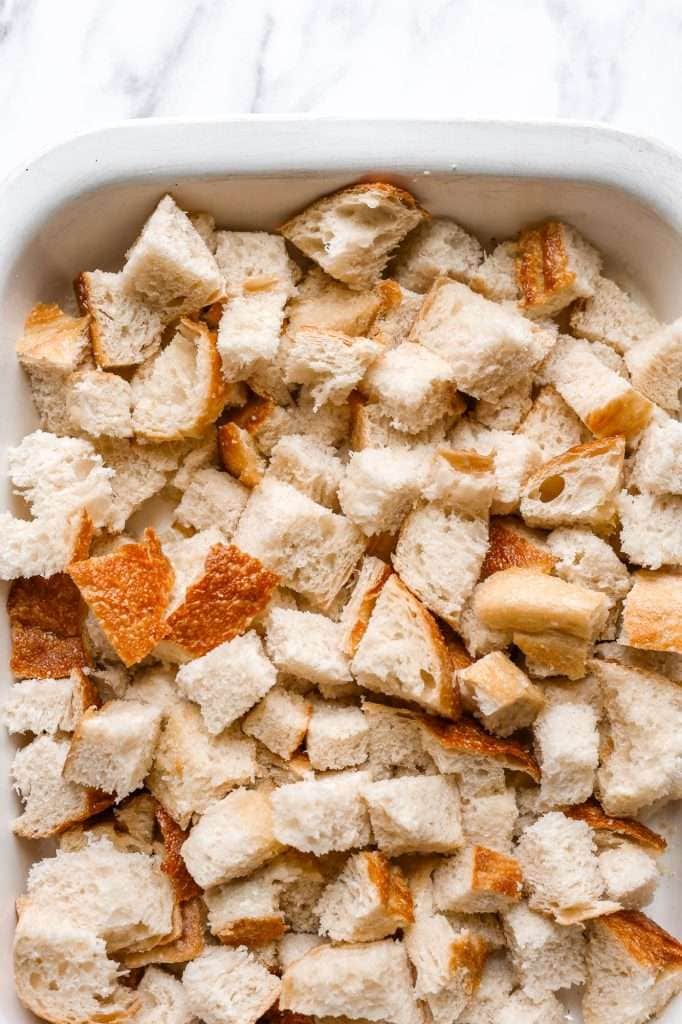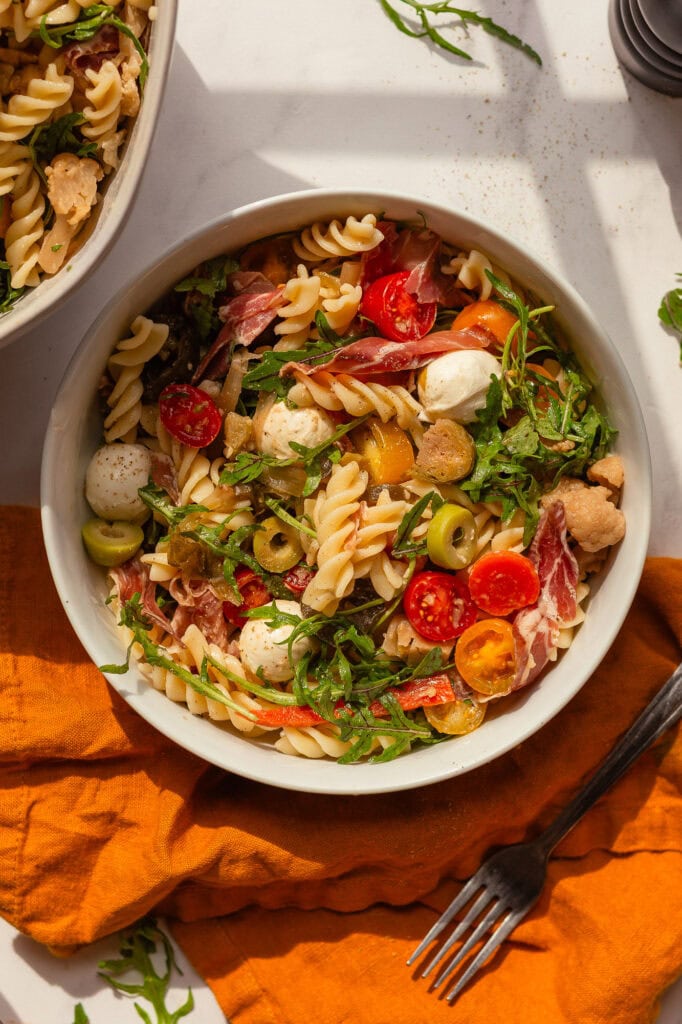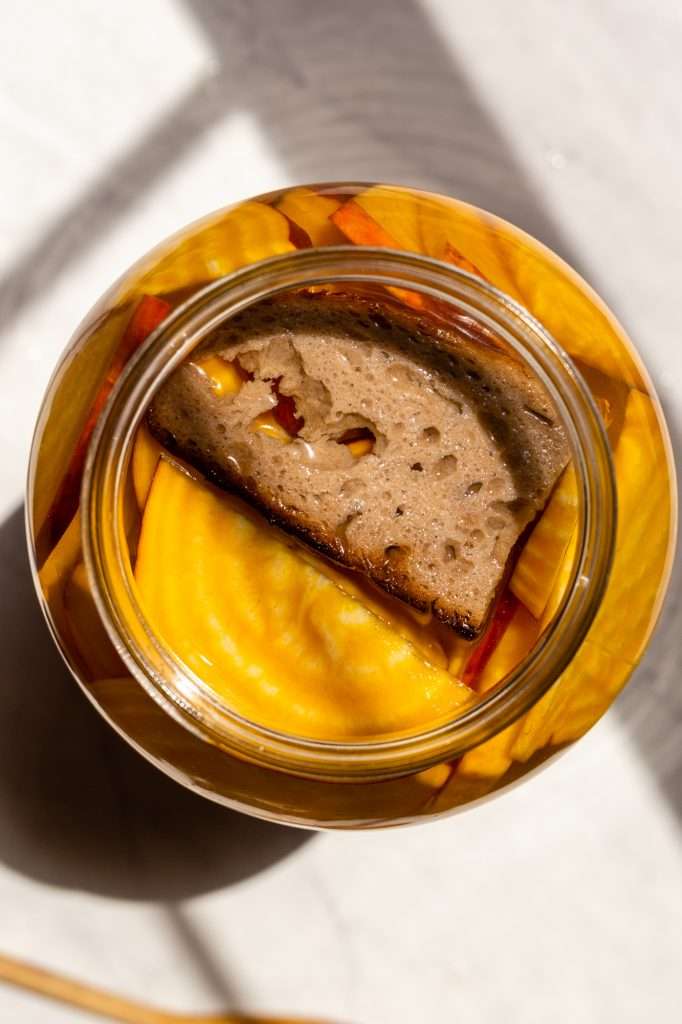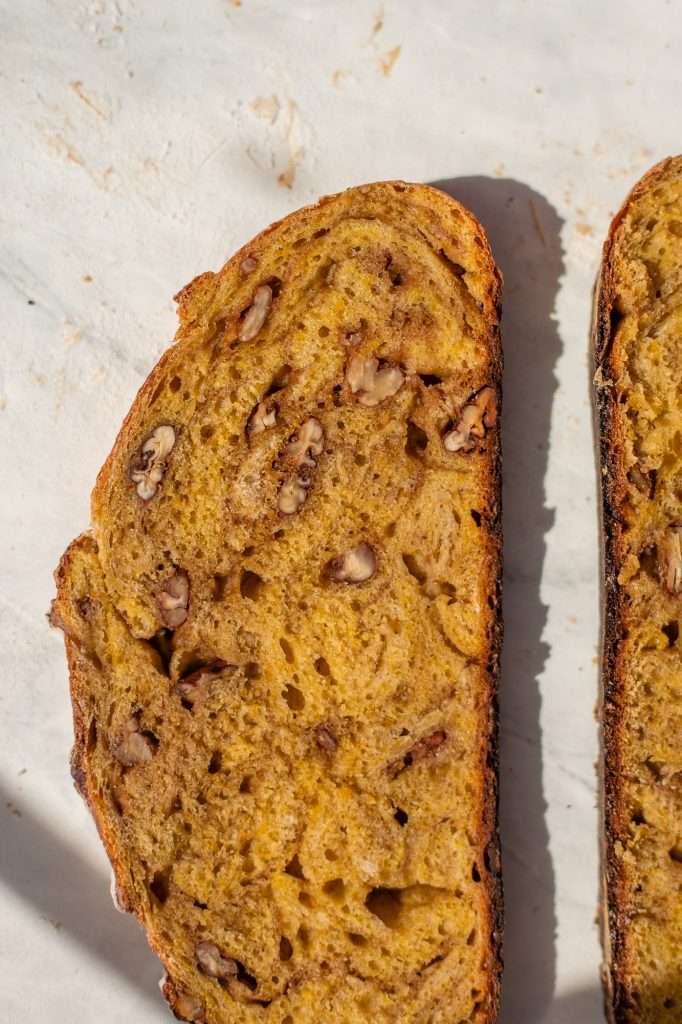The Best Bread to Make Stuffing
Sourdough stuffing is just the best. Sourdough bread is an excellent choice for stuffing due to its unique flavor and texture. Here are a few reasons why sourdough works well for stuffing:
- Flavor: Sourdough bread has a distinct, slightly tangy flavor that can add depth and complexity to your stuffing. This tanginess can complement a variety of ingredients commonly used in stuffing, such as herbs, onions, and celery.
- Texture: Sourdough tends to have a denser and chewier texture than white bread, which helps it maintain its structure when mixed with broth or other liquids. So it can absorb flavors well without becoming too mushy.
- Versatility: Sourdough pairs well with various flavors, from traditional herbs and spices to more adventurous combinations. So, sourdough is an excellent base for classic and innovative stuffing recipes.
- Crisping Ability: The crust of sourdough bread can crisp up nicely when baked, adding a pleasant texture contrast to the softer interior of the stuffing.
- Dietary Considerations: For those looking for a more nutritious option, sourdough is often made with whole grains and has a lower glycemic index than white bread.
When using sourdough for stuffing, I recommend using bread that’s a day or two old, as slightly stale bread will hold up better when soaked with broth or other liquids. I also like to toast the bread cubes in the oven before making the stuffing to enhance the texture and flavor.

Sourdough Stuffing for Thanksgiving
Stuffing, also known as dressing in some regions, has become a traditional side dish for Thanksgiving due to a combination of historical, cultural, and practical reasons:
- Historical Roots: In the context of American Thanksgiving, the tradition of stuffing birds before cooking traces back to the early settlers and their harvest celebrations. Stuffing poultry was reasonably common in European cuisine.
- Practicality: Stuffing was a practical way to use up stale bread and other leftovers. During times when food conservation was crucial, this was an efficient way to create a flavorful dish without wasting resources. The ingredients used in stuffing (such as bread, onions, and herbs) were readily available and affordable.
- Harvest Celebration: Thanksgiving is a celebration of the harvest, and stuffing made with bread, herbs, and vegetables represents the bounty of the harvest season. This ties in well with the theme of giving thanks for the year’s produce and provisions.
- Complement to Turkey: Turkey became the centerpiece of Thanksgiving in the United States, and stuffing pairs exceptionally well with it. The flavors of the stuffing complement the taste of turkey, and cooking them together allows the flavors to meld, enhancing the overall taste.
- Symbolic Dish: Like turkey, cranberry sauce, and pumpkin pie, stuffing has become symbolically associated with Thanksgiving. It’s part of the traditional image of the holiday feast and a key element of the celebration for many families.
These factors combined have solidified stuffing’s role as a quintessential Thanksgiving side dish, enjoyed by millions across the United States during the holiday.

How Dry Should Bread Be For Stuffing?
For making stuffing, it’s ideal for the bread to be somewhat dry but not completely hard. The dryness level affects how well the bread absorbs flavors and retains its structure when mixed with wet ingredients like broth, butter, and eggs.
Bread that’s a day or two old is typically best for stuffing. Fresh bread can become too mushy and soggy when mixed with wet ingredients, whereas slightly stale bread has lost some moisture, making it better at absorbing flavors without disintegrating.
Remember, the key to great stuffing is balance. You want the bread dry enough to soak up the flavors and moisture from the other ingredients but not so dry that it becomes tough or crumbly after cooking.

Sourdough Sausage Stuffing with Mushrooms
I love adding sausage to my stuffing. It adds such great flavor and texture to the dish. I feel like, with the added protein, I could eat a plate of this stuffing for a meal!
Sourdough sausage stuffing with mushrooms may sound fancy, but it’s quite simple. Here are all the ingredients you need for the recipe:
- 1 loaf sourdough bread
- 1 stick salted butter
- 4 ribs celery, finely minced
- 1 large yellow onion, minced
- 1 shallot, minced
- 3 cups baby portobello mushrooms, chopped
- 1 lb ground pork sausage
- 2 sprigs fresh sage
- 2 sprigs fresh rosemary
- 3 cups chicken broth
- 2 large eggs
- 2 tsp salt
- 1/2 teaspoon pepper



Can You Freeze Sourdough Stuffing?
You can prepare this recipe well before Thanksgiving and freeze it until ready to serve. It usually freezes quite well. Freezing is a great way to preserve leftovers, too.
Here are some tips for freezing and reheating this sourdough stuffing:
- Cooling the Stuffing: Before freezing, allow the stuffing to cool completely to room temperature. This reduces condensation, which can lead to sogginess when reheating.
- Packaging: Use airtight containers to store the stuffing. If using bags, remove as much air as possible before sealing. This helps prevent freezer burn and extends the shelf life of the stuffing.
- Thawing: When ready to use the stuffing, thaw it in the refrigerator for several hours or overnight. Avoid thawing at room temperature.
- Reheating: To reheat, place the stuffing in a baking dish, cover it with aluminum foil, and warm it in the oven at a moderate temperature (around 350°F) until heated through. If the stuffing seems dry, add a bit of broth or water before reheating to moisten it. Remove the foil for the last few minutes of baking for a crispier top.

Equipment for Making Sourdough Stuffing
You mainly need two things to make this stuffing: a large skillet for cooking the sausage and mushroom mix and a large, deep baking pan.


Sourdough Stuffing with Sausage, Mushrooms and Sage
Sourdough stuffing is the most delicious Thanksgiving side dish. Made from scratch with sourdough bread, portobello mushrooms, pork sausage, and sage, this sourdough sausage stuffing will impress your dinner guests!
- Prep: 20 minutes
- Cook: 30 minutes
- Total Time: 50 minutes
Ingredients
- 1 sourdough loaf
- 1 stick salted butter
- 3 ribs celery, finely minced
- 1 medium yellow onion, minced
- 1 shallot, minced
- 3 cups baby portobello mushrooms, chopped
- 1 lb ground pork sausage
- 1 sprig fresh sage
- 1 sprig fresh rosemary
- 3 cups chicken broth
- 2 large eggs
- 2 tsp salt
- 1/2 teaspoon pepper
Instructions
- In a skillet over medium-low, melt half of the butter. Simmer one sprig of rosemary and one sprig of sage in the butter for 2-3 minutes, until fragrant. Remove the herb sprigs from the butter.
- Add the onion, celery, mushrooms, and shallot to the herbed butter, and cook until they are soft and begin to brown.
- Add the ground pork sausage and cook until browned. Do not drain the fat.
- Preheat the oven to 350 F.
- Add the other half of the butter to a large casserole baking dish and place in the oven to melt.
- Cut the sourdough bread into 1-inch cubes.
- Remove the melted butter from the oven and toss the melted butter with the bread.
- Bake the sourdough bread for 20 minutes, stirring at 10 minutes to toast the bread evenly.
- Pull the toasted bread out of the oven.
- In a large bowl, whisk together the eggs, salt and broth.
- Scoop the sausage mushroom mixture into the toasted bread and toss to combine evenly.
- Pour the broth and egg mixture over the bread and let it sit for 10 minutes to soak.
- Place the remaining herbs on top of the stuffing.
- Bake for about 30 minutes, until it’s golden brown.



















